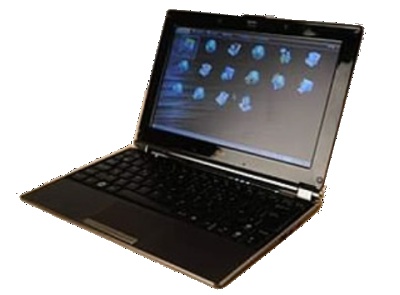Asus (re)spins $200 netbook
Nov 3, 2008 — by LinuxDevices Staff — from the LinuxDevices Archive — 1 views Netbook pioneer Asus will introduce a new version of its Eee PC (left) next year for just $200, says company president Jerry Shen. The company has also teamed up with Intel to launch a new website, intended to bring about the “world's first community-designed PCs.”
Netbook pioneer Asus will introduce a new version of its Eee PC (left) next year for just $200, says company president Jerry Shen. The company has also teamed up with Intel to launch a new website, intended to bring about the “world's first community-designed PCs.”
(Click here for a slightly larger view of the original EEE PC)
Asus is credited with touching off the netbook explosion with its Eee PC (above), tipped to cost just $200 when it was first shown off by company officials in June 2007. The device eventually shipped for $400 in Nov. 2007, with a seven-inch screen, a 900MHz Celeron processor, and the Linux operating system.
Since then, the company has released a bewildering variety of Eee netbooks. For example, March 2008 brought the EEE PC 900, still with a Celeron CPU but stepping up to a nine-inch screen. In June, Asus announced the Eee PC 901 and 1000, with Intel Atom N270 processors plus nine- and 10-inch screens, respectively.

The Asus PCS101 “fashion-forward” netbook
(Click for further information)
Eee PCs offer a variety of screen sizes and hard disk drives as large as 160GB. Most recently, Asus released the PCS101 (above), a “fashion-forward” device that houses typical netbook ingredients in metallic brown, graphite, and champagne, with “crystal adorned hinges.” The PCS101 will reportedly sell for up to $800, and like most Asus Eee PCs, will ship with either Linux or Windows XP.
But now, according to Shen, Asus plans to bring the netbook concept back to its low-cost roots. During a conference call set up to discuss the company's third-quarter financial results, posted yesterday, he said “next year, you can expect an entry-level Eee PC for around $200.”
Shen also suggested that Asus will work to prune the Eee PC product proliferation that has confused some potential buyers, phasing out models with seven- and nine-inch screens.
Other figures cited by Shen during the conference call included the following:
- Windows XP now dominates Eee PC shipments, enjoying a 7:3 lead over Linux
- Asus hopes to grab a 30 percent share in the netbook market in 2009, shipping from 6 to 7.5 million units out of an overall market estimated at 20-25 million
- Netbooks with hard drives are the mainstream specification, accounting for 70 percent of shipments
The Eee PC contributes around 22 percent of Asus' revenues, compared to traditional notebooks at 47 percent, motherboard and graphics cards at 19 percent, handheld devices at two percent, and “other products” at 10 percent, according to the company.
Shen said November will see the release of the Eee Top, an all-in-one device that includes an integrated 15-inch touchscreen, a 1.6GHz Intel Atom processor, 1GB of RAM, a 160GB hard drive, and a gigabit Ethernet port. He added that the Eee Top range will be expanded in January and March 2009 with two new models, which have elsewhere been rumored to include integral batteries and wireless keyboards.
A new design community …
Separately, Asus and Intel announced WePC.com, a website intended to “enable a global conversation about the ideal elements of PCs.” Visitors to the site will be able to share ideas for new PC designs, vote on submitted concepts, and engage in discussions with other community members, according to the companies.
The website will include three “conversation groups,” devoted to netbooks, notebooks, and gaming notebooks.” Intel and Asus ultimately “hope to bring to market a consumer-inspired product in each category,” and also plan to award prizes to participants, though no details were announced.
Mike Hoefflinger, general manager of Intel's partner marketing group, said “Intel believes the spark for innovation can come from anywhere. That's why Intel is working with Asus to tap into the creative energy of consumers.”
Further information
For more information about the WePC.com project, visit the website, here. To download a presentation with Asus' financial results and hear a Q&A with president Jerry Shen, visit the company's investor relations website, here.
This article was originally published on LinuxDevices.com and has been donated to the open source community by QuinStreet Inc. Please visit LinuxToday.com for up-to-date news and articles about Linux and open source.